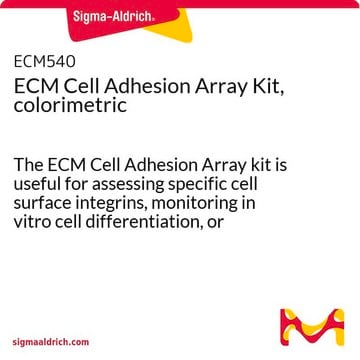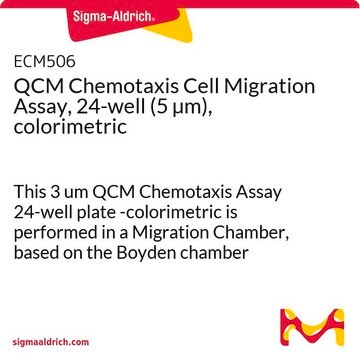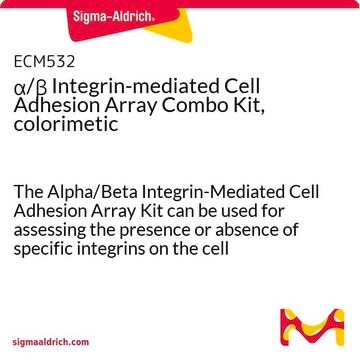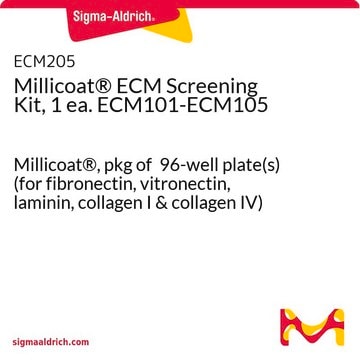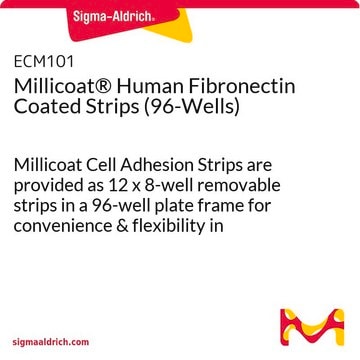ECM545
ECM Cell Adhesion Array Kit, fluorometric
The ECM Cell Adhesion Array kit is useful for assessing specific cell surface integrins, monitoring in vitro cell differentiation, or screening potential cell adhesion promoters/inhibitors.
Synonym(s):
Cell Adhesion Kit, ECM Adhesion Array
Sign Into View Organizational & Contract Pricing
All Photos(1)
About This Item
UNSPSC Code:
12352207
eCl@ss:
32161000
NACRES:
NA.84
Recommended Products
Quality Level
species reactivity
human
manufacturer/tradename
Chemicon®
technique(s)
cell based assay: suitable
detection method
fluorometric
shipped in
wet ice
General description
Introduction:
Cell adhesion plays a major role in cellular communication and regulation, and is of fundamental importance in the development and maintenance of tissues. Scientists are continually examining the adhesion, migration, and invasion of many diverse cell types on various extracellular matrix (ECM) component proteins. The CHEMICON® ECM Cell Adhesion Array Kit (Fluorometric) provides an ECM Array microtiter plate with a homogenous fluorescence detection format, allowing for large-scale screening and quantitative comparison of multiple samples/cell lines. The kit is designed as a rapid (1-2 hours), cost effective, efficient method for characterization of cell adhesion.
In addition, Chemicon continues to provide numerous migration, invasion, and adhesion products including:
· Alpha Integrin-Mediated Cell Adhesion Array Kit (Colorimetric) (ECM530)
· Beta Integrin-Mediated Cell Adhesion Array Kit (Colorimetric) (ECM531)
· Alpha/Beta Integrin-Mediated Cell Adhesion Array Combo Kit (Colorimetric) (ECM532)
· Alpha Integrin-Mediated Cell Adhesion Array Kit (Fluorometric) (ECM533)
· Beta Integrin-Mediated Cell Adhesion Array Kit (Fluorometric) (ECM534)
· Alpha/Beta Integrin-Mediated Cell Adhesion Array Combo Kit (Fluorometric) (ECM535)
· ECM Cell Adhesion Array Kit (Colorimetric) (ECM540)
· QCM 8μm 96-well Chemotaxis Cell Migration Assay (ECM510)
· QCM 5μm 96-well Chemotaxis Cell Migration Assay (ECM512)
· QCM 3μm 96-well Chemotaxis Cell Migration Assay (ECM515)
· QCM 96-well Cell Invasion Assay (ECM555)
· QCM 96-well Collagen-Based Cell Invasion Assay (ECM 556)
· 24-well Insert Cell Migration and Invasion assay systems
· CytoMatrix Cell Adhesion strips (ECM protein coated)
· QuantiMatrix ECM protein ELISA kits
Test Principle:
The CHEMICON ECM Cell Adhesion Array kit utilizes a homogenous fluorescence detection format, allowing large-scale screening and quantitative comparison of multiple samples. Each kit contains a 96-well, microtiter plate consisting of 12 X 8-well removable strips. Each well within a strip (7 wells total) is pre-coated with a different ECM protein (see table below) along with one BSA-coated well (negative control). Experimental cells are seeded onto the coated substrates, where adherent cells are captured. Subsequently, unbound cells are washed away, and the adherent cells are lysed and detected by the patented CyQuant GR dye (Molecular Probes) (1-2). This green-fluorescent dye exhibits strong fluorescence enhancement when bound to cellular nucleic acids (3). Relative cell attachment is determined using a fluorescence plate reader.
Additional information about the ECM components provided in the kit:
Cell adhesion plays a major role in cellular communication and regulation, and is of fundamental importance in the development and maintenance of tissues. Scientists are continually examining the adhesion, migration, and invasion of many diverse cell types on various extracellular matrix (ECM) component proteins. The CHEMICON® ECM Cell Adhesion Array Kit (Fluorometric) provides an ECM Array microtiter plate with a homogenous fluorescence detection format, allowing for large-scale screening and quantitative comparison of multiple samples/cell lines. The kit is designed as a rapid (1-2 hours), cost effective, efficient method for characterization of cell adhesion.
In addition, Chemicon continues to provide numerous migration, invasion, and adhesion products including:
· Alpha Integrin-Mediated Cell Adhesion Array Kit (Colorimetric) (ECM530)
· Beta Integrin-Mediated Cell Adhesion Array Kit (Colorimetric) (ECM531)
· Alpha/Beta Integrin-Mediated Cell Adhesion Array Combo Kit (Colorimetric) (ECM532)
· Alpha Integrin-Mediated Cell Adhesion Array Kit (Fluorometric) (ECM533)
· Beta Integrin-Mediated Cell Adhesion Array Kit (Fluorometric) (ECM534)
· Alpha/Beta Integrin-Mediated Cell Adhesion Array Combo Kit (Fluorometric) (ECM535)
· ECM Cell Adhesion Array Kit (Colorimetric) (ECM540)
· QCM 8μm 96-well Chemotaxis Cell Migration Assay (ECM510)
· QCM 5μm 96-well Chemotaxis Cell Migration Assay (ECM512)
· QCM 3μm 96-well Chemotaxis Cell Migration Assay (ECM515)
· QCM 96-well Cell Invasion Assay (ECM555)
· QCM 96-well Collagen-Based Cell Invasion Assay (ECM 556)
· 24-well Insert Cell Migration and Invasion assay systems
· CytoMatrix Cell Adhesion strips (ECM protein coated)
· QuantiMatrix ECM protein ELISA kits
Test Principle:
The CHEMICON ECM Cell Adhesion Array kit utilizes a homogenous fluorescence detection format, allowing large-scale screening and quantitative comparison of multiple samples. Each kit contains a 96-well, microtiter plate consisting of 12 X 8-well removable strips. Each well within a strip (7 wells total) is pre-coated with a different ECM protein (see table below) along with one BSA-coated well (negative control). Experimental cells are seeded onto the coated substrates, where adherent cells are captured. Subsequently, unbound cells are washed away, and the adherent cells are lysed and detected by the patented CyQuant GR dye (Molecular Probes) (1-2). This green-fluorescent dye exhibits strong fluorescence enhancement when bound to cellular nucleic acids (3). Relative cell attachment is determined using a fluorescence plate reader.
Additional information about the ECM components provided in the kit:
Application
Research Category
Cell Structure
Cell Structure
The ECM Cell Adhesion Array kit is useful for assessing specific cell surface integrins, monitoring in vitro cell differentiation, or screening potential cell adhesion promoters/inhibitors.
The ECM Cell Adhesion Array kit is useful for assessing specific cell surface integrins, monitoring in vitro cell differentiation, or screening potential cell adhesion promoters/inhibitors.
For Research Use Only. Not for use in diagnostic procedures.
For Research Use Only. Not for use in diagnostic procedures.
Packaging
96 wells
Components
ECM Array Plate: (PN: 90652) One 96-well plate with 12 strips. Each 8-well strip consists of 7 different human, ECM protein-coated wells (Collagen I, Collagen II, Collagen IV, Fibronectin, Laminin, Tenascin, Vitronectin) and one BSA-coated well (negative control). See the plate layout on data sheet.
4X Cell Lysis Buffer: (Part No. 90130) One bottle - 16 mL.
CyQuant GR™ Dye: (Part No. 90132) One vial - 75 μL.
Assay Buffer: (Part No. 90601) One bottle - 100 mL.
4X Cell Lysis Buffer: (Part No. 90130) One bottle - 16 mL.
CyQuant GR™ Dye: (Part No. 90132) One vial - 75 μL.
Assay Buffer: (Part No. 90601) One bottle - 100 mL.
Storage and Stability
The ECM Array Plate can be stored at 2° to 8°C in the foil pouch up to its expiration date. Unused strips may be placed back in the pouch for storage. Ensure that the desiccant remains in the pouch, and that the pouch is securely closed. Keep the remaining kit components at 2° to 8°C.
Precautions:
No data is available on the biological toxicity of CyQuant GRâ dye. This reagent binds to nucleic acids, and as such, should be treated as a potential mutagen which may cause cancer and heritable genetic damage. Handle with caution. The DMSO stock solution should be handled with special caution as DMSO can facilitate the entry of organic molecules into tissues.
Precautions:
No data is available on the biological toxicity of CyQuant GRâ dye. This reagent binds to nucleic acids, and as such, should be treated as a potential mutagen which may cause cancer and heritable genetic damage. Handle with caution. The DMSO stock solution should be handled with special caution as DMSO can facilitate the entry of organic molecules into tissues.
Legal Information
CHEMICON is a registered trademark of Merck KGaA, Darmstadt, Germany
GR is a trademark of Sigma-Aldrich Co. LLC
Disclaimer
Unless otherwise stated in our catalog or other company documentation accompanying the product(s), our products are intended for research use only and are not to be used for any other purpose, which includes but is not limited to, unauthorized commercial uses, in vitro diagnostic uses, ex vivo or in vivo therapeutic uses or any type of consumption or application to humans or animals.
Signal Word
Danger
Hazard Statements
Precautionary Statements
Hazard Classifications
Aquatic Acute 1 - Aquatic Chronic 2 - Eye Dam. 1
Storage Class Code
10 - Combustible liquids
Certificates of Analysis (COA)
Search for Certificates of Analysis (COA) by entering the products Lot/Batch Number. Lot and Batch Numbers can be found on a product’s label following the words ‘Lot’ or ‘Batch’.
Already Own This Product?
Find documentation for the products that you have recently purchased in the Document Library.
Ashley C Kramer et al.
Stem cell reports, 9(3), 770-778 (2017-08-29)
The hematopoietic marrow microenvironment is composed of multiple cell types embedded in an extracellular matrix (ECM). We have explored marrow ECM using mass spectrometry and found dermatopontin (DPT), a small non-collagenous ECM protein, to be present. We found that DPT
Agne Frismantiene et al.
Cell adhesion & migration, 12(1), 69-85 (2017-05-20)
Vascular smooth muscle cell (SMC) switching between differentiated and dedifferentiated phenotypes is reversible and accompanied by morphological and functional alterations that require reconfiguration of cell-cell and cell-matrix adhesion networks. Studies attempting to explore changes in overall composition of the adhesion
J J Gildea et al.
BioTechniques, 29(1), 81-86 (2000-07-25)
Current in vitro assays used in assessing tumor motility could be improved by the development of a simple technique that would facilitate studies of the impact of specific genes on pharmacologically altered chemotaxis. We developed a technique that improves on
Bessi Qorri et al.
Cancers, 14(6) (2022-03-26)
Resistance to chemotherapeutics and high metastatic rates contribute to the abysmal survival rate in patients with pancreatic cancer. An alternate approach for treating human pancreatic cancer involves repurposing the anti-inflammatory drug, aspirin (ASA), with oseltamivir phosphate (OP) in combination with
Shengguang Chen et al.
Molecular medicine reports, 16(3), 2425-2430 (2017-07-06)
Previous studies have confirmed that exposure to particulate matter with a diameter of ≤2.5 µm (PM2.5) is associated with inflammation. PM2.5 decreases cardiac cell viability and increases apoptosis through overproduction of reactive oxygen species (ROS). In the present study, the role
Our team of scientists has experience in all areas of research including Life Science, Material Science, Chemical Synthesis, Chromatography, Analytical and many others.
Contact Technical Service